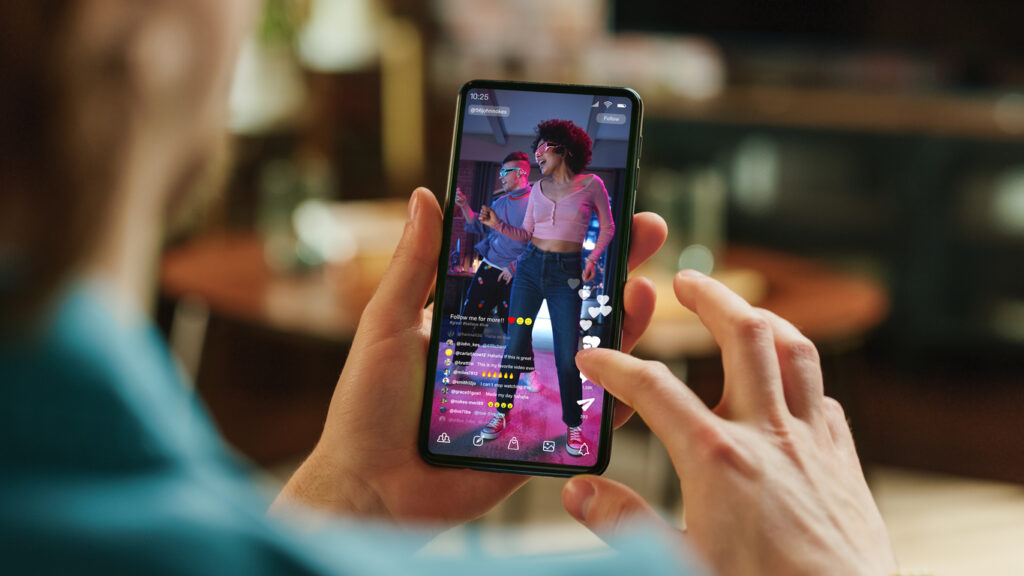The Sticky debate: video v copy
Figure out your audience and the kinds of videos they want…Think about which platform your videos are going on and tailor them to that.
Choosing the right medium is essential for creating content that has a long-lasting impact, is value for money and suits your audience. Video is the newer kid on the block, while writing has been around thousands of years. Here we look at the value of both and what you need to consider before taking the plunge.
Why video matters – Zoe Dickinson, Producer?
Video is huge online. From its launch in 2005 with founder Jawed Karim publishing its very first video “Me at the zoo” YouTube has grown to around 2.49 billion monthly active users. That’s 47% of all global internet users accessing YouTube every single month. And it’s not just YouTube, TikTok has already got 1.12 billion monthly active users since launching in 2016.
And as soon as you have a new platform you have content marketers trying to see if it works for them and their brand. So why choose video?
Humans are hard-wired for visual information. Writing developed late on in evolution, while spotting something that you could eat or would eat you was vital to survival. Visual information matters.
Things to recognise:
- Many people find video more engaging. They’re more likely to engage with video than with text or images alone.
- We live in a digital age. People entertain themselves on socials with TikTok reels and video. They’re willing to commit their time and attention to the moving image in its various forms.
- Video has SEO benefits – Google may prioritise video content – assuming you’ve set them up to be indexed correctly. And YouTube is the second biggest (or third depending on how you count) search engine.
The triple advantage of video
Video is the complete package. It offers dynamic storytelling as it benefits from visual, text and sound design so you can grab audience attention on all accounts very quickly. It’s also well-suited to different kinds of learning styles too – with it’s a triple mix of visuals, audio, and text. So, you can watch, listen or read or a combination of all three to get the information you need.
Visual storytelling
Video can also offer a big emotional impact. Visual storytelling can create a stronger connection with the audience. It offers a more immersive experience for those watching – compared with just text. Dear Dorothy our award-winning video for Jaguar Land Rover, will definitely tug the heartstrings.
Story telling can lift the mundane. Pinterest swapped a standard corporate presentation about why they are the right platform for advertisers for a video – Pinterest Presents 2024. They went for a mockumentary-style approach, making it feel more like a comedy show than a typical B2B summit. I think the mix of humour, storytelling, and engaging visuals kept people watching – especially given it’s nearly 45 minutes long. And it worked – 32,000+ people signed up, and nearly 14,000 watched live, with barely anyone dropping off.
This was an example of an interesting video that turned what could be quite a dull event into something more engaging and creating conversation.
Live streaming
It’s not just recorded video that’s growing in popularity. Live streaming is also getting bigger and other interactive content like live Q&As where the audience can interact with whoever is in the video. It all adds to the more personal feel and engagement – in a way text never can.
To be truthful here, we also have to remember some of the things you need to consider if opting for video.
- It’s more expensive than copy – creating a quality video can cost a lot even if it’s just a few seconds long.
- It’s a lengthy process – it takes time to make good videos.
- It takes expertise – you need a lot of kit and editing software, although maybe this is less of a drawback these days as there are free phone apps and a lot of phones have high quality cameras.
A happy future for video in the age of AI
AI is already making a difference around video. Its tools are being used to make videos, for visuals, voice, and sound. But even more importantly it’s being used to develop ideas, concepting, helping write or refine scripts. It may help reduce costs as it becomes easier and quicker to show a client a concept.
Another thing to be aware of, video content seems to be getting shorter especially on social media – even YouTube has YouTube shorts now. This has advantages for the viewer. It makes brands concentrate on what really matters in their message to keep it succinct. Or in providing a number of shorter videos it gives viewers the chance to pick and choose the bits they really want to watch.
So what do you need to know?
When considering integrating video content into your strategy for the first time you should:
- Start simple and you can always get bigger and more complicated as you go.
- Figure out your audience and the kinds of video they want
- Think about which platform your videos are going on and tailor them to that. Different types and lengths of video won’t always do well on every platform.
- Use storytelling to engage people.
- Sound can be super important – good sound design and the right music can elevate a video so much. And also consider your sonic branding.
- Talk to us about any video content you require – we can help from short animations or TikToks to explainers, to brand videos. And take a look at our work for the London Museum, Barefoot and Ageas to see examples of how we make video work for different sorts of clients.
Why written content matters – Bridie Pritchard – Senior editor and content strategist
Written content is brilliant for marketing – don’t write it off just yet. We’ve been writing – and reading – for around 5,000 years. It’s lasted that long because it’s both practical and useful. Film has been around for a maximum of a century and a half. A newcomer. Humans are used to communicating meaningfully around the written word. We’ve been practising a long time and are good at it.
Well-written content has huge advantages that marketers shouldn’t forget.
- It makes it really easy to find the information that we need and want. Well-structured copy signals what is contained in a piece with headings – so users can find it very quickly. no fast forwarding and then reversing when you’ve overshot. With a simple Control F on PCs you can usually find a word or phrase on a web page, PDF or document.
- Video can be a real time suck. How much do you have to watch to find the one gem in it? Scan readers can quickly check a piece of copy out and understand how valuable it might be and whether it’s worth investing the time. It’s hard to know what’s in a video without actually spending the time watching it. It’s far quicker to check out a document.
- Copy is also very office friendly. No sudden blare out of your computer speaker making it look like you are not working.
- Written materials can provide sharp focus on what’s important. You’re not being distracted by images and sound. You can concentrate on what’s important.
- Written content can have a heft that more ephemeral video doesn’t. With everyone having a video phone in their pocket, video can feel transitory and disposable in a way that a report or white paper doesn’t.
- It’s much easier to refer back to something in written content than in a video. It’s also easier to reread a sentence or a paragraph if you get interrupted or want to check you’ve properly understood it.
- Copy can be more memorable and meaningful. Think of the slogans – Just do it/I’m lovin’ it/Because you’re worth it – we’ve seen them written down so many times they are engraved in our memory.
- Copy can be really useful to help users self-serve, sort out their own problems and make good decisions or choices. From concise and precise instructions for processes, to accurate product descriptions good copy can make the difference between customer satisfaction or complaint.
- Compared with video, it’s cheaper and easier to produce. It’s also wayeasier to keep up to date. Web pages can be updated with new figures, for example.
- And whatever anyone says about video being more engaging – written copy can be too. People will cry or laugh just as much at a book or article they are reading as a video.
Copy is your flexible friend
When storytelling you can do the classic being able to tell a whole story in just six words “For sale. Baby shoes. Never worn.” Alternatively you can write the detail of Finnegan’s Wake or War and Peace. The same applies to copy for brands. Words can stretch and flex as far as you need them to. Want a few words for a punchy billboard? Simple. Or an exquisite memorable description of a meal or holiday destination. Easily done. Want to share the depth of your knowledge and understanding in a white paper that gets referred to often. All you need is a sound scaffold to write it. Want to talk to your users where they are – then social posts can talk their language. And let’s face it most videos will need a script too…
Your choice of words, your tone of voice and your content structure will all reinforce your brand values. No one will be hunting around for a mug in the brand’s colour late at night for a prop before a shoot.
What you need to consider
We get taught it at school, so everyone thinks they can write. But not everyone can write effectively or engagingly. And sometimes that may be senior people in your organisation.
Add AI into the mix and you can find too much blah copy churned out. If sites use cheap AI produced copy like wallpaper, it will eventually devalue a brand if reading it feels like wading through treacle.
So you need to make sure your content is engaging and high quality.
The future of copy
The written word has lasted for more than 5,000 years so it has still got a future. There will be a different and changing relationship as Gen Z and Gen A who have grown up in the era of online and mobile video move through the workforce and various life stages. Video will still hold a place – it’s probably easier to watch a video of learning how to cast on in knitting than have someone describe how to do it. So what will happen is that each medium will get better used for the things that it is good at and less used where it is weakest. A happy co-existence is the best future possible.
So what do marketers need to know?
- Brands should talk with one coherent tone of voice – that can flex appropriately for different situations.
- Have a thought through content strategy, so the right content is being produced in a timely way for the appropriate audience. And somebody driving that strategy
- There’s no right number of words – you should write what something is worth for the platform it will appear on – and the audience’s attention span. See more on long-form v short form content and taglines
- Content should work for the where it needs to go. UX copywriting needs to be functional, product descriptions need to be both informative and enticing, a blog post needs to be engaging, entertaining and even helpful.
- Know your audience and understand why you are writing something – what you want your audience to think, feel or do after reading it.
- Maximise value from your content. That brilliant blog post can be signposted on socials, for example.
You can talk to us about all your content needs, from content strategy, editorial calendars, tone of voice, content audits to your content production needs such as blog posts, articles, brochures, whitepapers, UX copy, site rewrites on migration, video scripts, digital copywriting training and more. Get in touch today.

Bridie Pritchard
Senior Editor and Content Strategist



